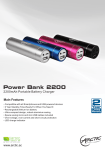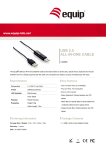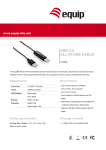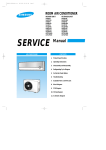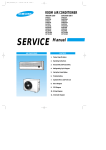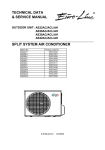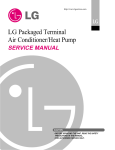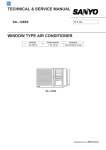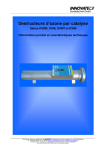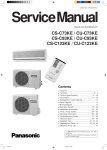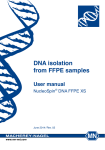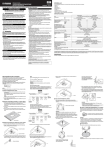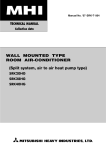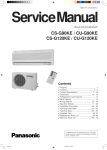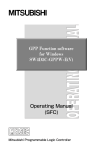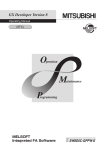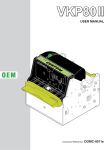Download technical & service manual window type air
Transcript
TECHNICAL & SERVICE MANUAL SA– 79G SA– 99G FILE NO. WINDOW TYPE AIR CONDITIONER Model No. Product Code No. SA-79G-A 1 851 005 18 SA-99G-A 1 851 005 19 Destination General (50Hz) & Europe SA– 79G SA– 99G REFERENCE NO. SM700402 When Installing IMPORTANT! Please Read Before Starting Place of Installation • If possible, install the unit in a shady location. If the site is exposed to the sun, you should provide a sun screen as shown in Fig. a. This air conditioner meets strict safety and operating standards. As the installer or service person, it is an important part of your job to install or service the system so it operates safely and efficiently. • Install it at a spot where optimum cooling circulation can be obtained. No chairs or other obstructions are allowed in front of the air conditioner. For safe installation and trouble-free operation, you must: • The back of the air conditioner must extend outside. (Be sure the right and left intake vents are not obstructed by walls or windows.) • Carefully read the INSTRUCTION MANUAL and INSTALLATION INSTRUCTIONS attached to each air conditioner before beginning. • Keep more than 50 cm from any outside obstruction (wall, bush, etc.). • Follow each installation or repair step exactly as shown. • To provide water drainage, the unit must be tilted at a downward angle 0.5 to 1 cm to the outside. • Observe all local, state, and national electrical codes. • Pay close attention to all warning and caution notices given in this manual. WARNING CAUTION Screen Wall This symbol refers to a hazard or unsafe practice which can result in personal injury or product or property damage. Room side Front grille Support Enough space from obstacle or wall. If Necessary, Get Help These instructions are all you need for most installation sites and maintenance conditions. If you require help for a special problem, contact our sales/service outlet or your certified dealer for additional instructions. Tilt 0.5 to 1 cm downward to outside. Fig. a • While installing the air conditioner, be sure to loosen the compressor locking nuts to avoid abnormal noise and vibration. (NOTE: Locking nuts are not provided on some models.) SPECIAL PRECAUTIONS WARNING Outside This symbol refers to a hazard or unsafe practice which can result in severe personal injury or death. When Wiring • As a safety measure, it is recommended that two people install the unit: one to hold and balance the unit — the other to lower the window frame to secure the unit. ELECTRICAL SHOCK CAN CAUSE SEVERE PERSONAL INJURY OR DEATH. ONLY A QUALIFIED, EXPERIENCED ELECTRICIAN SHOULD ATTEMPT TO WIRE THIS SYSTEM. • Hold the unit securely, and be careful to not drop the cabinet or any parts if the air conditioner is being installed on an upper floor of a multistory building. • All wiring must conform to local electrical codes. When Servicing • Each unit must be properly grounded with a ground (or earth) wire or through the supply wiring. • DO NOT, under any circumstances, cut or remove the third (ground) prong from the power cord plug. • Turn the power OFF at the main power box (mains) before opening the unit to check or repair electrical parts and wiring. • DO NOT use an adapter Plug or extension cord. • Keep fingers and clothing away from any moving parts. • DO NOT use a damaged power cord, plug, or wall outlet. Replace them immediately. • Clean up the site after you finish, remembering to check that no metal scraps or bits of tools have been left inside the unit being serviced. • DO NOT change the internal wiring or any part of the system. Others • DO NOT turn the air conditioner on and off by plugging and unplugging. Use the Operation switch. CAUTION When Transporting • Ventilate any enclosed areas when installing or testing the refrigeration system. Escaped refrigerant gas, on contact with fire or heat, can produce dangerously toxic gas. Be careful when picking up and moving the air conditioner. Get a partner to help, and bend your knees when lifting to reduce strain on your back. Sharp edges or thin aluminum fins on the air conditioner can cut your fingers. • Confirm upon completing installation that no refrigerant gas is leaking. If escaped gas comes in contact with a stove, gas water heater, electric room heater or other heat source, it can produce dangerously toxic gas. i HOW TO USE THIS MANUAL This manual is designed to help service personnel to understand basic functions, operation and possible troubles and their remedies on SANYO window type air conditioners. You can use this manual both as a reference to find specific information about the capacity, construction of the unit, and as a source of information to help you set up and maintain the air conditioner. Please use this manual to make your work easier, keep the air conditioner functioning well, and keep your customer satisfied. Please read IMPORTANT ! precautional information on the previous page before you start actual work. SANYO WINDOW TYPE A/C NOMENCLATURE SANYO window type air conditioner is identified by a model number. Cooling or heating capacity, electrical information and special features included on the air conditioner are indicated on the model number. Example SA– 79G Type SA : SANYO window type A/C Capacity Special Features G : Mechanical Control, Cooling Model, Side Air Discharge 7 : 7,000 BTU/h class 9 : 9,000 BTU/h class Design Number NOTE To identify the correct model number of your air conditioner, you must find the nameplate. ii Table of Contents Page 1. OPERATING RANGE ............................................................................................................................... 1 2. SPECIFICATIONS 2-1. Unit Specifications .......................................................................................................................... 2 2-2. Major Component Specifications ................................................................................................... 4 2-3. Other Component Specifications.................................................................................................... 6 3. DIMENSIONAL DATA............................................................................................................................... 7 4. REFRIGERANT FLOW DIAGRAM .......................................................................................................... 8 5. PERFORMANCE DATA 5-1. Cooling Capacity ........................................................................................................................... 9 6. ELECTRICAL DATA 6-1. Electric Characteristics .................................................................................................................. 11 6-2. Electric Wiring Diagram .................................................................................................................. 12 7. TROUBLESHOOTING 7-1. Check before and after troubleshooting ........................................................................................ 13 7-2. Air conditioner does not operate .................................................................................................... 14 7-3. Some part of air conditioner does not operate .............................................................................. 16 7-4. Air conditioner operates, but abnormalities are observed ............................................................. 18 8. CHECKING ELECTRICAL COMPONENTS 8-1. Measurement of Insulation Resistance .......................................................................................... 8-2. Checking Motor Capacitor .............................................................................................................. 8-3. Checking Fan Motor Winding ......................................................................................................... 8-4. Checking Compressor Motor Winding............................................................................................ 27 20 20 20 9. DISASSEMBLY PROCEDURES 9-1. Removing Front Grille..................................................................................................................... 9-2. Removing Cabinet .......................................................................................................................... 9-3. Removing Electrical Component Box ............................................................................................. 9-4. Removing Evaporator..................................................................................................................... 9-5. Removing Blower Wheel ................................................................................................................ 9-6. Removing Condenser..................................................................................................................... 9-7. Removing Propeller Fan................................................................................................................. 9-8. Removing Fan Motor ...................................................................................................................... 21 22 22 23 23 24 24 24 APPENDIX Unit Display and Control Panel ............................................................................................ 25 iii 1. OPERATING RANGE Temperature Cooling Indoor Air Intake Temp. Outdoor Air Intake Temp. Maximum 32°C D.B. / 23°C W.B. 43°C D.B. Minimum 19°C D.B. / 14°C W.B. 19°C D.B. 1 2. SPECIFICATIONS 2-1. Unit Specifications Model SA– 79G Power Source 220–240V Single phase 50Hz Voltage rating 220 / 230 / 240 V Performance Cooling Capacity kW BTU/h m3/h Liters/h Air circulation (High) Moisture removal (High) 2.10 7,200 / / Electrical Rating 2.10 7,200 360 1.3 / / 2.10 7,200 / / / / / 3.4 800 98 2.63 16 Cooling Available voltage range Running amperes Power input Power factor C.O.P. Starting ampere V A W % W/W A 3.6 770 97 2.73 15 / / / / / 198 ~ 264 3.5 780 97 2.69 16 Features Controls / Temperature control Control unit Timer Fan speeds Airflow direction (Indoor) Air filter / Air exhaust Compressor Refrigerant / Amount charged at shipment Refrigerant control Operation sound Indoor : Hi / Lo Outdoor : Hi / Lo Slide-out chassis Accessories Mechanical / Thermostat — — 2 Auto Manual Washable / Yes Rotary (Hermetic) R22 / 480 Capillary tube 45 / 41 52 / 47 Yes — Horizontal Vertical g dB-A dB-A Dimensions & Weight Unit dimensions Package dimensions Weight Shipping volume Height Width Depth Height Width Depth Net Shipping mm mm mm mm mm mm kg kg m3 345 440 605 416 536 700 34 36 0.16 Remarks: Rating conditions are: Cooling : Indoor air temperature 27°C D.B. / 19°C W.B. Outdoor air temperature 35°C D.B. / 24°C W.B. 2 DATA SUBJECT TO CHANGE WITHOUT NOTICE. Model SA– 99G Power Source 220–240V Single phase 50Hz Voltage rating 220 / 230 / 240 V Performance Cooling Capacity kW BTU/h m3/h Liters/h Air circulation (High) Moisture removal (High) 2.55 8,700 / / Electrical Rating 2.55 8,700 360 1.3 / / 2.60 8,900 / / / / / 4.4 1,000 95 2.60 18 Cooling Available voltage range Running amperes Power input Power factor C.O.P. Starting ampere V A W % W/W A 4.5 960 97 2.66 18 / / / / / 198 ~ 264 4.4 980 97 2.60 18 Features Controls / Temperature control Control unit Timer Fan speeds Airflow direction (Indoor) Air filter / Air exhaust Compressor Refrigerant / Amount charged at shipment Refrigerant control Operation sound Indoor : Hi / Lo Outdoor : Hi / Lo Slide-out chassis Accessories Mechanical / Thermostat — — 2 Auto Manual Washable / Yes Rotary (Hermetic) R22 / 650 Capillary tube 46 / 42 53 / 48 Yes — Horizontal Vertical g dB-A dB-A Dimensions & Weight Unit dimensions Package dimensions Weight Shipping volume Height Width Depth Height Width Depth Net Shipping mm mm mm mm mm mm kg kg m3 345 440 605 416 536 700 36 38 0.16 Remarks: Rating conditions are: Cooling : Indoor air temperature 27°C D.B. / 19°C W.B. Outdoor air temperature 35°C D.B. / 24°C W.B. 3 DATA SUBJECT TO CHANGE WITHOUT NOTICE. 2-2. Major Component Specifications Model SA– 79G Controller PCB Part No. Controls Control circuit fuse — — — Remote Control Unit — Compressor Type Compressor model Source Nominal output Compressor oil ... Amount Coil resistance (Ambient temp. 25°C) Safety devices Run capacitor Rotary (Hermetic) 2P14C225AND 220 / 240V 1-phase 50Hz 725 SUNISO 4GDID ... 270 C–R : 4.48 C–S : 5.25 External protector MRA98854-9201 Automatic opening W cc Ω Type Overload relay Operating temp. Open °C Close °C Operating amp.(Ambient temp. 25°C) µF VAC Automatic reclosing — 25 400 Fan & Fan Motor Indoor Type Dia. / Depth Fan motor model ... Q'ty Source No. of poles ... rpm (230 V, High) Nominal output Coil resistance (Ambient temp. 20°C) Safety devices Run capacitor Type Operating temp. Centrifugal Propeller ø180 / D85 ø285 / D90.7 YSK45-4A/K ... 1 220 - 240V 1-phase 50Hz 4 ... 960 40 WHT-BRN : 212 WHT-VLT : 52 VLT-YEL : 13 YEL-RED(PNK) : 119 Internal protector 135 Automatic reclosing 3.0 440 mm W Ω Open Close Outdoor °C °C µF VAC Heat Exch. Coil Coil Rows Fin pitch Face area Evaporator 2 1.2 0.070 mm m2 External Finish Condenser 2 1.6 0.115 Acrylic baked-on enamel finish DATA SUBJECT TO CHANGE WITHOUT NOTICE. 4 Model SA– 99G Controller PCB Part No. Controls Control circuit fuse — — — Remote Control Unit — Compressor Type Compressor model Source Nominal output Compressor oil ... Amount Coil resistance (Ambient temp. 25°C) Safety devices Run capacitor Rotary (Hermetic) 2P17C225AND 220 / 240V 1-phase 50Hz 920 SUNISO 4GDID ... 350 C–R : 3.61 C–S : 4.97 External protector MRA98776 Automatic opening W cc Ω Type Overload relay Operating temp. Open °C Close °C Operating amp.(Ambient temp. 25°C) µF VAC Automatic reclosing — 25 400 Fan & Fan Motor Indoor Type Dia. / Depth Fan motor model ... Q'ty Source No. of poles ... rpm (230 V, High) Nominal output Coil resistance (Ambient temp. 20°C) Safety devices Run capacitor Type Operating temp. Centrifugal Propeller ø180 / D85 ø285 / D90.7 YSK45-4A/K ... 1 220 - 240V 1-phase 50Hz 4 ... 1,000 40 WHT-BRN : 212 WHT-VLT : 52 VLT-YEL : 13 YEL-RED(PNK) : 119 Internal protector 135 Automatic reclosing 3.5 440 mm W Ω Open Close Outdoor °C °C µF VAC Heat Exch. Coil Coil Rows Fin pitch Face area Evaporator 3 1.4 0.070 mm m2 External Finish Condenser 3 1.8 0.115 Acrylic baked-on enamel finish DATA SUBJECT TO CHANGE WITHOUT NOTICE. 5 2-3. Other Component Specifications Model SA – 79G SA – 99G Auto Deflector Motor MA062299 Rating Coil resistance AC 200/240V, 50/60Hz, 20mA, 4W, 5.0/6.0 rpm kΩ (at 20°C) 9.92 6 3. DIMENSIONAL DATA Model SA – 79G SA – 99G 605 440 241✽ ✽ 228 345 46 Side view (L) Power code outlet Front view Power code outlet Slits for ventilation Side view (R) Unit : mm NOTE Dimension with "✻" mark indicates the maximum allowable wall thickness required for ventilating the unit. 7 4. REFRIGERANT FLOW DIAGRAM Model SA – 79G Compressor Condenser Evaporator Accumulator Capillary tube SA – 99G Accumulator Compressor Condenser Evaporator Model Capillary tube 8 5. PERFORMANCE DATA 5-1. Cooling Capacity Model SA– 79G 240V Single Phase 50Hz RATING CAPACITY AIR FLOW RATE EVAPORATOR ENT. TEMP. °C W.B. D.B. 2.10 kW 360 m3/h CONDENSER OUTDOOR AMBIENT TEMP. °C 20 25 30 35 40 TC 2.12 2.02 1.93 1.84 1.73 CM 0.53 0.58 0.62 0.66 0.73 21 SHC 1.38 1.33 1.29 1.24 1.18 15 23 SHC 1.55 1.50 1.45 1.40 1.35 25 SHC 1.72 1.67 1.62 1.57 1.51 27 SHC 1.88 1.83 1.78 1.74 1.68 29 SHC 2.05 2.00 1.93 1.84 1.73 31 SHC 2.12 2.02 1.93 1.84 1.73 TC 2.27 2.17 2.07 1.97 1.86 CM 0.55 0.59 0.63 0.68 0.75 21 SHC 1.21 1.16 1.11 1.07 1.01 17 23 SHC 1.38 1.33 1.28 1.23 1.18 25 SHC 1.54 1.49 1.45 1.40 1.34 27 SHC 1.71 1.66 1.61 1.56 1.51 29 SHC 1.88 1.83 1.78 1.73 1.67 31 SHC 2.04 1.99 1.94 1.90 1.84 TC 2.42 2.31 2.21 # 2.10 1.97 CM 0.56 0.61 0.65 0.70 0.77 21 SHC 1.03 0.98 0.93 0.88 0.83 19 23 SHC 1.20 1.15 1.10 1.05 1.00 25 SHC 1.36 1.31 1.26 1.22 1.16 27 SHC 1.53 1.48 1.43 1.38 1.33 29 SHC 1.69 1.64 1.60 1.55 1.49 31 SHC 1.86 1.81 1.76 1.72 1.66 TC 2.56 2.45 2.34 2.23 2.09 CM 0.58 0.63 0.67 0.72 0.80 23 SHC 1.01 0.96 0.91 0.87 0.81 21 25 SHC 1.18 1.13 1.08 1.03 0.98 27 SHC 1.34 1.29 1.25 1.20 1.15 29 SHC 1.51 1.46 1.41 1.37 1.31 31 SHC 1.67 1.63 1.58 1.53 1.48 TC 2.72 2.60 2.48 2.34 2.19 CM 0.59 0.64 0.69 0.74 0.82 23 25 SHC 0.98 0.93 0.88 0.83 0.78 27 SHC 1.15 1.10 1.05 1.00 0.94 29 SHC 1.31 1.27 1.22 1.16 1.11 31 SHC 1.48 1.43 1.38 1.33 1.27 TC : Total Cooling Capacity (kW) SHC : Sensible Heat Capacity (kW) CM : Compressor Input (kW) Rating conditions (#Mark) are Outdoor Ambient Temp. 35°C D.B. Indoor Unit Entering Air Temp. 27°C D.B. / 19°C W.B. 9 45 1.59 0.80 1.11 1.28 1.45 1.59 1.59 1.59 1.71 0.82 0.94 1.11 1.27 1.44 1.61 1.71 1.82 0.85 0.76 0.93 1.09 1.26 1.43 1.59 1.93 0.87 0.75 0.91 1.08 1.25 1.41 2.03 0.89 0.72 0.89 1.05 1.22 Model SA– 99G 240V Single Phase 50Hz RATING CAPACITY AIR FLOW RATE EVAPORATOR ENT. TEMP. °C W.B. D.B. 2.60 kW 360 m3/h CONDENSER OUTDOOR AMBIENT TEMP. °C 20 25 30 35 40 TC 2.62 2.51 2.39 2.28 2.14 CM 0.68 0.73 0.78 0.84 0.94 21 SHC 1.70 1.64 1.58 1.52 1.45 15 23 SHC 1.90 1.84 1.78 1.72 1.64 25 SHC 2.09 2.03 1.97 1.91 1.84 27 SHC 2.29 2.23 2.17 2.11 2.04 29 SHC 2.49 2.42 2.36 2.28 2.14 31 SHC 2.62 2.51 2.39 2.28 2.14 TC 2.81 2.69 2.57 2.44 2.30 CM 0.70 0.75 0.80 0.86 0.97 21 SHC 1.50 1.44 1.38 1.32 1.25 17 23 SHC 1.70 1.63 1.57 1.51 1.44 25 SHC 1.89 1.83 1.77 1.71 1.64 27 SHC 2.09 2.03 1.96 1.90 1.83 29 SHC 2.28 2.22 2.16 2.10 2.03 31 SHC 2.48 2.42 2.36 2.30 2.23 TC 2.99 2.86 2.73 # 2.60 2.44 CM 0.72 0.77 0.83 0.89 1.00 21 SHC 1.28 1.22 1.16 1.10 1.03 19 23 SHC 1.48 1.42 1.36 1.30 1.23 25 SHC 1.68 1.61 1.55 1.49 1.42 27 SHC 1.87 1.81 1.75 1.69 1.62 29 SHC 2.07 2.01 1.95 1.89 1.82 31 SHC 2.26 2.20 2.14 2.08 2.01 TC 3.17 3.03 2.89 2.76 2.59 CM 0.74 0.80 0.85 0.91 1.02 23 SHC 1.26 1.20 1.14 1.08 1.01 21 25 SHC 1.46 1.40 1.34 1.28 1.21 27 SHC 1.65 1.59 1.53 1.47 1.41 29 SHC 1.85 1.79 1.73 1.67 1.60 31 SHC 2.04 1.98 1.92 1.87 1.80 TC 3.36 3.22 3.07 2.89 2.71 CM 0.75 0.82 0.87 0.94 1.05 23 25 SHC 1.22 1.17 1.10 1.04 0.97 27 SHC 1.42 1.36 1.30 1.23 1.16 29 SHC 1.62 1.56 1.50 1.43 1.36 31 SHC 1.81 1.75 1.69 1.63 1.56 TC : Total Cooling Capacity (kW) SHC : Sensible Heat Capacity (kW) CM : Compressor Input (kW) Rating conditions (#Mark) are Outdoor Ambient Temp. 35°C D.B. Indoor Unit Entering Air Temp. 27°C D.B. / 19°C W.B. 10 45 1.97 1.05 1.36 1.56 1.76 1.95 1.97 1.97 2.11 1.07 1.16 1.36 1.55 1.75 1.94 2.11 2.25 1.10 0.95 1.14 1.34 1.54 1.73 1.93 2.38 1.13 0.93 1.13 1.32 1.52 1.71 2.52 1.16 0.90 1.09 1.29 1.49 6. ELECTRICAL DATA 6-1. Electrical Characteristics Model SA– 79G Fan Motor Performance at Rating Conditions Compressor Complete Unit 220 / 240 V Single phase 50Hz Running Amps. Power Input Full Load Conditions Running Amps. Power Input A 0.38 / 0.40 kW 0.086 / 0.099 A 0.38 / 0.40 kW 0.086 / 0.099 3.22 / 3.00 0.684 / 0.701 5.12 / 3.80 1.014 / 0.891 3.6 / 0.77 / 5.5 / 1.10 / 3.4 0.80 4.2 0.99 Rating Conditions : Indoor Air Temperature 27°C D.B. / 19°C W.B. Outdoor Air Temperature 35°C D.B. Full Load Conditions : Indoor Air Temperature 32°C D.B. / 23°C W.B. Outdoor Air Temperature 43°C D.B. Model SA– 99G Fan Motor Performance at Rating Conditions Compressor Complete Unit 220 / 240 V Single phase 50Hz Running Amps. Power Input Full Load Conditions Running Amps. Power Input A 0.42 / 0.45 kW 0.095 / 0.110 A 0.42 / 0.45 kW 0.095 / 0.110 Rating Conditions 4.08 / 6.28 / 4.95 1.235 / 1.160 : Indoor Air Temperature 27°C D.B. / 19°C W.B. Outdoor Air Temperature 35°C D.B. Full Load Conditions : Indoor Air Temperature 32°C D.B. / 23°C W.B. Outdoor Air Temperature 43°C D.B. 11 3.95 0.865 / 0.890 4.5 / 0.96 / 6.7 / 1.33 / 4.4 1.00 5.4 1.27 6-2. Electrical Wiring Diagrams Model SA-79G SA-99G WARNING To avoid electrical shock hazard, be sure to disconnect power before checking, servicing and/or cleaning any electrical parts. DATA SUBJECT TO CHANGE WITHOUT NOTICE. 12 7. TROUBLESHOOTING 7-1. Check before and after troubleshooting WARNING Hazardous voltage can cause ELECTRIC SHOCK or DEATH. Disconnect power or turn off circuit breaker before you start checking or servicing. 7-1-1. Check power supply. ● Check that voltage is in specified range (±10% of the rating). ● Check that power is being supplied. 7-1-2. Check lead wires and connectors. ● Check that coating of lead wires is not damaged. ● Check that lead wires and connectors are firmly connected. ● Check that wiring is correct. 13 7-2. Air conditioner does not operate. 7-2-1. Circuit breaker trips (or fuse blows). A. When the circuit breaker is set to ON, it is tripped soon. (Resetting is not possible.) ● There is a possibility of ground fault. ● Check insulation resistance. If resistance value is 2MΩ or less, insulation is defective (“NO”). Power plug (Field supply) Wall outlet (Receptacle) 1 Circuit breaker Window type air conditioner Power supply Ground WARNING * Set circuit breaker to OFF. 1 Pull the power plug out of the wall outlet. • Measure insulation resistance of unit. Insulation of unit is defective. NO • Measure insulation resistance of electrical parts. (Example) Compressor, Fan motor, Capacitor, Relay etc. NOTE 1. If any poorly insulated part is found, exclude that part from circuit with other parts properly connected, and then measure insulation resistance of entire air conditioner again to locate defective part. 2. Replace defective part with new one. 14 B. Circuit breaker trips in several minutes after turning the air conditioner on. ● There is a possibility of short circuit. • Check capacity of circuit breaker. Replace with suitable one (larger capacity). NO Capacity of circuit breaker is suitable. • Measure resistance of fan motor winding. • Measure resistance of compressor motor winding. 7-2-2. Neither fan motor nor compressor motor runs. A. Power is not supplied. • Check power supply. Circuit breaker is tripped. Reset breaker. Power failure. Wait for recovery or contact power company. NO Power is being supplied to the unit. B. Check OPERATION SELECTOR switch on the control panel. • Check that OPERATION SELECTOR switch is not set at "OFF". If it is set at OFF. 15 Set to "HIGH COOL" or "LOW COOL". 7-3. Some part of air conditioner does not operate. 7-3-1. Only fan does not run. • Check fan rotation. Turn fan gently once or twice by hand. • Check fan casing foreign matter on inside. Fan cannot be turned. Fan motor burnout or foreign matter in bearings. Remove foreign matter or repair. Repair or replace. • Measure resistance of fan motor winding. OK • Check fan motor capacitor. 7-3-2. Auto deflector switch does not work. • Check that OPERATION SELECTOR switch is set at either HIGH COOL or LOW COOL. OK • Measure resistance of auto deflector motor winding. NOTE Auto deflector does not work with the operation selector switch in FAN or OFF position. 16 7-3-3. Only compressor does not run. A. Check setting temperature. Is room temperature too low ? NO Try to lower setting temperature by thermostat knob COOLER. B. Check compressor and electrical parts. Overload relay is working. • Check compressor motor capacitor. YES • Measure resistance of compressor motor winding. Temperature of compressor is abnormally high. YES YES Refrigerant gas shortage. Charge refrigerant gas (R22). NO • Measure power supply voltage. The voltage is too low. No Rotor may be locked up. CAUTION ● If the unit is turned off during cooling, DO NOT restart it immediately, as this can damage it. Wait at least three minutes before starting it again. 17 7-4. Air conditioner operates, but abnormalities are observed. 7-4-1. Poor cooling • Measure temperature of suction and discharge air of air conditioner. Temperature difference is small. Possibility of gas shortage. Charge refrigerant gas (R22). Temperature difference between suction and discharge air is large enough (approx. 10 deg. or more). Check for clogging of air filter. Clean filter. Air filter is clogged. • Fan speed is set to LOW. YES Set fan speed to HIGH. • Review cooling load estimate, if performance of air conditioner is normal. Reduce cooling load or replace the air conditioner with larger capacity. 7-4-2. Excessive cooling • Set temperature is suitable. Set temperature to higher value using thermostat on the control panel. NO 18 8. CHECKING ELECTRICAL COMPONENTS 8-1. Measurement of Insulation Resistance Power plug (Field supply) ● The insulation is in good condition if the resistance exceeds 2MΩ. Ground Probe 8-1-1. Power Cord and Unit Insulation tester Clamp the grounding prong of the power plug with a lead clip of the insulation resistance tester and measure the resistance by placing a probe on either of the two power blade. (Fig. 1) Fig. 1 NOTE ● The shape of the power plug may differ from that of the air conditioner which you are servicing. Then, also measure the resistance between the grounding prong and other power blade. (Fig. 1) 8-1-2. Measurement of Insulation Resistance for Electrical Parts Probe Disconnect the lead wires of the desired electric part from terminal plate, switch, capacitor, etc. Similarly disconnect the connector. Then measure the insulation resistance. (Figs. 2 to 3) Refer to Electric Wiring Diagram. NOTE If the probe cannot enter the poles because the hole is too narrow then use a probe with a thinner pin. Clip Copper tube or metallic part Insulation tester Fig. 2 From fan motor, compressor and other parts Metallic part Probe Clip Insulation tester 19 Fig. 3 8-2. Checking Motor Capacitor Remove the lead wires from the capacitor terminals, and then place a probe on the capacitor terminals as shown in Fig. 4. Observe the deflection of the pointer, setting the resistance measuring range of the multimeter to the maximum value. Multimeter The capacitor is “good” if the pointer bounces to a great extent and then gradually returns to its original position. The range of deflection and deflection time differ according to the capacity of the capacitor. 8-3. Checking Fan Motor Winding Referring to the electrical diagram, disconnect fan motor connectors, and measure the resistance between each lead wire with a tester. Fig. 4 The tester should be set in the X1 range. If the fan motor is hot, allow a few minutes until it gets cooled down. When the resistances between each lead wire are those listed in "2-2. Major Component Specifications" the fan motor should be normal. Multimeter ,,,,,,,,,, ,,,,,,,,,, ,,,,,,,,,, ,,,,,,,,,, ,,,,,,,,,, ,,,,,,,,,, ,,,,,,,,,, ,,,,,,,,,, ,,,,,,,,,, ,,,,,,,,,, 8-4. Checking Compressor Motor Winding Compressor motor coil terminal Checking compressor motor winding can be done in the similar manner. Remove the terminal cover of the compressor motor, set the resistance measuring range of the multimeter to "X1Ω" and check the continuity between each pair out of the 3 terminals as shown in Fig. 5. Refer to "2-2. Major Component Specifications" for coil resistance. 20 Fig. 5 9. DISASSEMBLY PROCEDURES Model SA – 79G SA – 99G NOTE These illustrations are based on typical view of a standard model. Consequently, the shape may differ from that of the air conditioner which you are servicing. 9-1. Removing Front Grille Fig. 1 (1) Open the air intake. (2) Remove the screw holding the grille in place. (Fig. 1) (3) Slide the side of the grille to the left and right to disengage the tabs on the left and right sides of the grille from the slots. (4) Pull the bottom portion of the grille toward you while paying attention to the ventilator lever. (Fig. 2 and 4) NOTE Pulling out too far on the bottom of the grille at this point could damage the tabs at the top. Do not pull the grille out more than 100 mm. Grille Cabinet (5) After confirming that the ventilator lever has been disengaged from the grille vent, slide the grille upward to free the two tabs at the top of the grille from the rectangular holes in the top of the cabinet. (Fig. 3 and 4) Slot Tab Pull out 70mm – 100mm Fig. 2 Slot Air deflection grille Tab Grille Cabinet Ventilator lever Fig. 4 21 Fig. 3 9-2. Removing Cabinet (1) Remove screws A and B. (Fig. 5) (2) Remove the front grille. Refer to "9-1. Removing Front Grille" (3) Remove the stopper screw attached to the base pan of the unit (Fig. 6) Screw B (4) While holding top of the cabinet with one hand, grasp the handle with another hand and pull the unit toward you. (Fig. 7) Screw A Fig. 5 Fig. 6 Fig. 7 CAUTION Fins of evaporator are sharp and may cause injury if handled improperly; be careful when you deal with those parts. Stopper 9-3. Removing Electrical Component Box (1) Remove the air deflection grille. (Fig. 8) (2) Remove screws securing the electrical component box. (Fig. 9) (3) Remove screw holding the lid of the electrical component box. (Fig. 10) Fig. 8 Fig. 9 Fig. 10 22 9-4. Removing Evaporator (1) Remove the top plate. (Fig. 11) (2) Remove screws holding evaporator. (Fig. 11) (3) Grasp lower portion of the evaporator with both hands and tilt it slightly and lift it carefully from the drain pan so as not to distort the copper tube. Fig. 11 9-5. Removing Blower Wheel (1) Loosen a nut holding blower wheel on motor shaft using hex. wrench. (Fig. 12) (2) Extract the blower wheel from the motor shaft. Fig. 12 23 9-6. Removing Condenser (1) Remove the top plate. (Fig. 11) (2) Remove screws holding condenser. (Fig. 13) (3) Grasp lower portion of the condenser with both hands and tilt it slightly and lift it carefully from the base pan so as not to distort the copper tube. Top view Fig. 13 Fig. 14 9-7. Removing Propeller Fan (1) Remove the condenser. Refer to "9-6. Removing Condenser" (2) Loosen a nut holding propeller fan on motor shaft using hex. wrench. (Fig. 15) NOTE To loose the nut securing the propeller fan, hold the fan with one hand and turn the nut COUNTERCLOCKWISE with another hand. (3) Extract the propeller fan from the motor shaft. Fig. 15 9-8. Removing Fan Motor (1) Remove blower wheel. Refer to "9-5. Removing Blower Wheel" (2) Remove propeller fan. Refer to "9-7. Removing Propeller Fan" (3) Disconnect motor lead wires. (4) Remove 3 screws of the fan motor mounting plate with a philip screwdriver. (Fig. 16) (5) Disengage the fan motor from the mounting plate. (Fig. 11) Fig. 16 24 APPENDIX Model SA – 79G SA – 99G Unit Display and Control Panel VENTILATOR lever Close WAIT 3 MINUTES BEFORE RESTARTING THERMOSTAT knob 0 OPERATION SELECTOR switch 0 0 AUTO DEFLECTOR switch On 25 0 Off Off High Fan Low Fan Low Cool High Cool Open SANYO Electric Co.,Ltd. Osaka, Japan SM700402 Printed in Japan 06/99/200






























